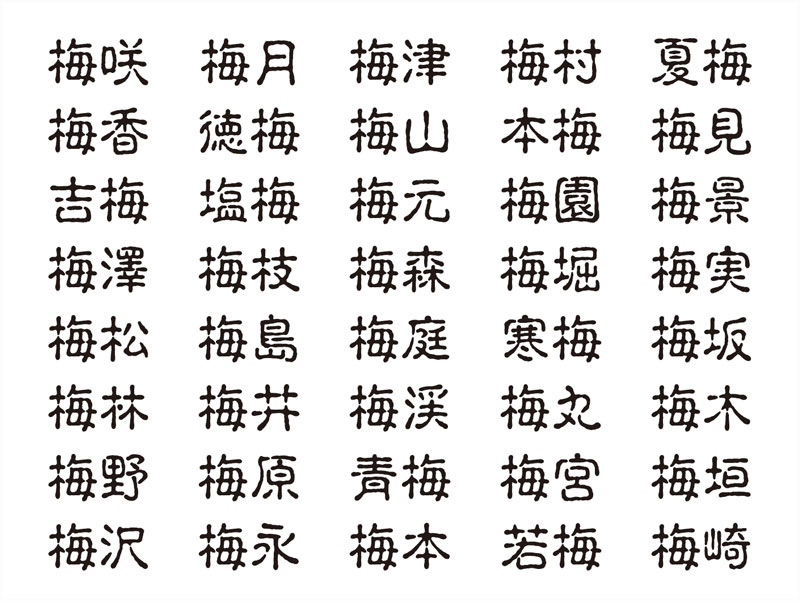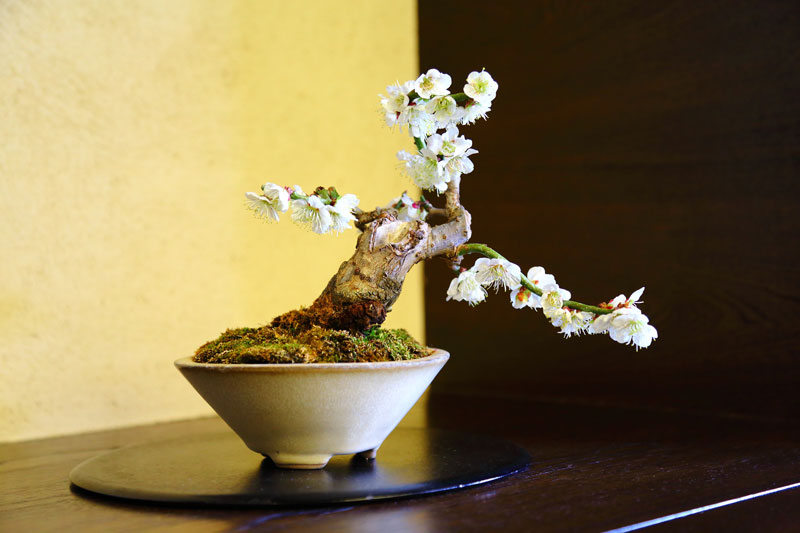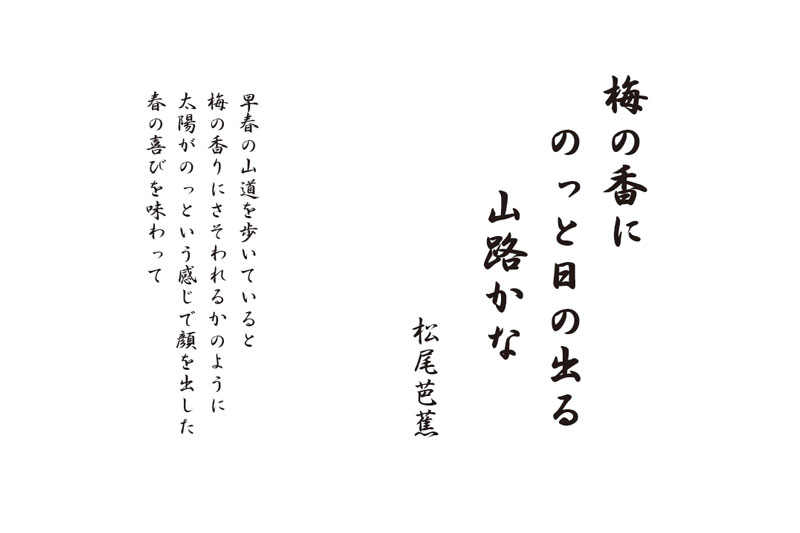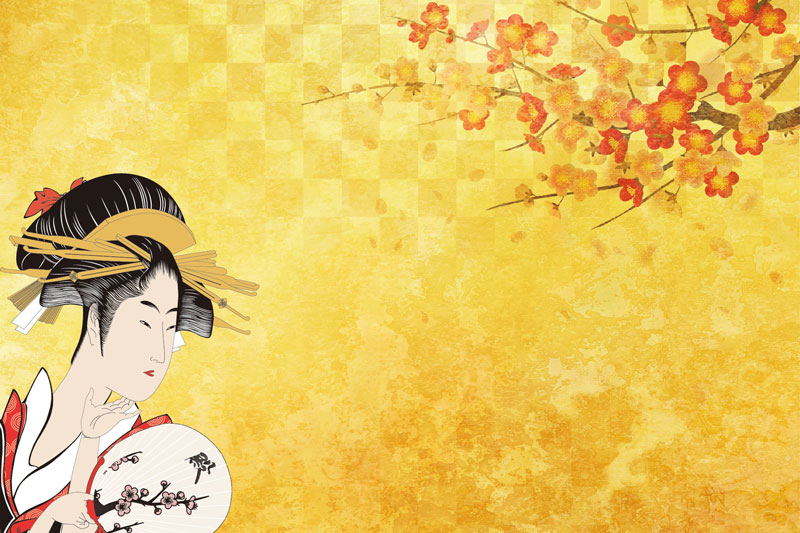Ume and Japan

Ume and Japanese CultureIn Japan, the most well known flower was the Ume blossom, a flower which makes people feel the arrival of Spring. The many arts and traditions themed on Ume are evidence of this. The Ume continues to be a flower that is close to the Japanese people’s hearts, even in the 21st century.
Ume and Japanese Culture
-
-

Ume and Japanese Culture
- In Japan, the most well known flower was the Ume blossom, a flower which makes people feel the arrival of Spring. Ume is an important plant for the Japanese people, both for its blossoms and as food. Many families enjoy Ume by preserving them for Umeboshi or as umeshu when the Ume blossoms finish blooming. Again, Kishu’s Nanko-Ume is popular as an ingredient for top-quality Umeboshi. Traditional Umeboshi is sour and salty, but reducing the salt and sourness has made Umeboshi very popular. The Umeboshi may one day become a global health food.
-
-
-

Ume and Japanese Cuisine
- Many people bring Umeboshi on trips and long stays overseas. Sushi, sukiyaki, and tempura are famous globally, but the types of Japanese dishes which we seem to never get tired of, even if we eat them every day, are white rice, miso soup, grilled fish, Umeboshi, pickled plums, and eggs. The Ume is embedded deep in the Japanese culture as an indispensable companion at our breakfast table.
-
-
-

Ume and Traditional Japanese Patterns
- The Ume (Japanese apricot) is often used as a motif for various Japanese traditional patterns. There are countless products that use the Ume motif, including kimonos, fabrics, paper, clothes, certain marks, printed goods, postcards, letters, fans, pottery, small containers, happi coats, handkerchiefs, noren curtains, towels, bags, and interior goods. This is how much Japanese people love the Ume and its blossoms.
-
-
-

Ume and Family Emblems – the Ume Emblem
- The Ume blossom has been loved by the Japanese since ancient times. There are several family emblems using the Ume blossom motif as well. Famous families which use the Umehachi emblem include the Maeda Family, which is famous for once being a Daimyo family of the Kaga Domain. Also, the Kitano Tenmangū Shrine, which deifies Sugawara no Michizane as the god of learning also uses an Ume related emblem. The most common Ume family emblem is the Umebachi, but there are other family emblems that use the Ume blossom motif, including Baika, Kasaneume, Mukou Ume, and Mitsumori Ume. And the mark on the bottom left is… Tonohata logo.
-
-
-

Ume and Art
- Ume has been used as a traditional Japanese motif for many pieces of art, including Japanese fusuma, pottery, kimono, and patterns. For example, “The Folding Screen of Red and White Plum Blossoms” is a national treasure and the masterpiece of painter Ogata Korin, painted during the Edo period. The contrast of the red and white plums, and the old and young trees, the originality of the river’s position, and the lines, curves and sense of balance with the flowing water all point to his genius.
-
-
-

Ume and Surnames
- There are many Japanese surnames that contain the kanji for Ume. It is said that during the Heian Period, location names were used for family names, as a means of clarifying land ownership among the developers and rules of the land. On the contrary, some location names were taken from family names. There are many surnames with Ume, such as Umei, Umetani, Umemaru, Umeki, Umeno, and Umehara, but there are about 500 people with the one-character surname, Ume.
-
-
-

Ume and Bonsai
- Ume bonsai trees are used to celebrate the New Year for good luck. This type of bonsai is called “Hanamono”, as the Ume bonsai tree produces flowers as well. It is known that bonsai became very popular during the Kamakura Period among samurais as a hobby. Some bonsai works with trees that are 100–300 years old still remain. Bonsai is also generating fans overseas.
-
-
-

Ume and Haikus
-
The Ume blossom, loved by Japanese people since the ancient times, is often mentioned in poetry as well.
- “The warmth comes with the blooming of each Ume blossom.” – Hattori Ransetsu
(In the early spring, the Ume blossoms start to bloom in the garden, and with each bloom, the climate becomes warmer each day.) - “On the mountain path, the sun suddenly shows its face, by the fragrance of Ume.” – Matsuo Bashō
(While walking in a mountain path in the early spring, the sun suddenly shows its face, as if lured by the fragrance of Ume, savoring the joy of spring.)
The Ume blossom is often used by modern Haiku poets as the “seasonal word” for early spring.
- “The warmth comes with the blooming of each Ume blossom.” – Hattori Ransetsu
-
-
-

Ume and Ume Blossom Viewing
- In February, when the chill has abated, Ume festivals for Ume viewing are held all over Japan. Some people take a leisurely walk among the petals, some bring their lunchboxes so they can eat while viewing the blossoms, and some hold parties. In mid-February, in Japan’s number one location for Ume, Minabe, Wakayama, the hometown of the Ume, the blossoms of the Ume farm start blooming all at once, creating an enchanting white haze over the mountains.
-
-
-

Ume and Kabuki Role: Ume-o-maru
- Kabuki is a Japanese traditional performance art. It a performance art that developed during the Edo period, and is one of three national performance arts that represent Japan, along with Noh and Japanese puppet show. The Ume makes its appearance in kabuki as well. In the famous play, “Sugawara Denju Tenarai Kagami”, which is based on the demotion of Sugawara no Michizane, worshipped as the god of learning, a young man with a strong sense of justice called Ume-o-maru appears on stage. The melodramatic calls from the audience is also what makes Kabuki so exciting!
-
-
-

Ume and Noh – Umegae
- The Ume motif also appears in Noh, one of the three national performance arts that represent Japan. The famous play called “Umegae” illustrates the heart-to-heart exchanges between a monk of Minobusan Mountain and the wife of the music performer Fuji who died in hatred. The song “Umegae,” performed during the play, got its title from the song, Etengaku, which goes, “Ume fruits grow on branches, and the bush warbler creates its nest”. Additionally, the play, “Dōjō-ji” is known as a play about Wakayama Prefecture.
-
-
-

Ume and Songs – “Have the Ume flowers bloomed? Is the Sakura blooming yet?”
- People have loved songs about Ume for a very long time. For example, “Have the Ume flowers bloomed? ” is an Edo folk song which is based on “Shongaebushi”, which was popular during the Meiji Period. It’s a song that goes, “Have the Ume flowers bloomed? Is the Sakura blooming yet? The willow blows in the direction of the wind”, and is loved as a song for geisha rooms that describes the geishas as seasonal flowers and seashells.
-
-
-

Ume and Idioms
-
There are many idioms that use Ume as its theme as well. For example:
- “Ume and the bush warbler.”
It refers to things that go well or beautifully together, just like the Ume and bush warbler. - “An Ume helps one escape the difficulties of the day.”
Many people like to eat white rice with Umeboshi in the morning. The idiom suggests that eating Umeboshi for breakfast will let you avoid difficulties and problems throughout the day.
Hanafuda is a type of Karuta, a traditional Japanese card game. It has recently started gaining popularity overseas as well.
- “Ume and the bush warbler.”
-
-
-

Ume and the Language of Flowers
- There are flower phrases for Ume (Japanese apricot) as well, like “elegance”, “dignity”, and “patience”. It makes us think of elegant and strong Japanese women. Additionally, the flower phrase for the red Ume flower, a flower that was loved by the famous writer, Sei Shōnagon, is “grace”. It’s a flower phrase that perfectly describes the flower’s dignified and brilliant form. If we widen our scope and look at the flower phrases for the plum, we find that the flower phrase for the plum blossom is “beauty and longevity, “keep your promise”, and “fidelity”.
-
-
-

Ume and the Rainy Season
- The kanji for the rainy season is “Ume” and “rain”, and is read as tsuyu or baiu. It refers to the rainy period during the early summer, between June and July. It’s said that this season got its name because the Ume fruits become ripe during this season. For the Ume, this season is a blessing because it receives rain. With each rainfall, the Ume fruits become bigger and bigger, until the time comes for harvest.
-
-
-

Ume and Ukiyo-e Art
- The Ume flower also appears in Ukiyo-e art, when it depicts the culture of Ume flower viewing. Illustrations with a beautiful woman viewing Ume flowers was very popular, including “Night Ume” as illustrated by the artist Utagawa Toyokuni during the Edo Period. Furthermore, among the One Hundred Famous Views of Edo illustrated by Utagawa Hiroshige, is an illustration of Kameido Umeyashiki, which was a very popular place for Ume flower viewing. They used to fix wooden barrels there.
-







